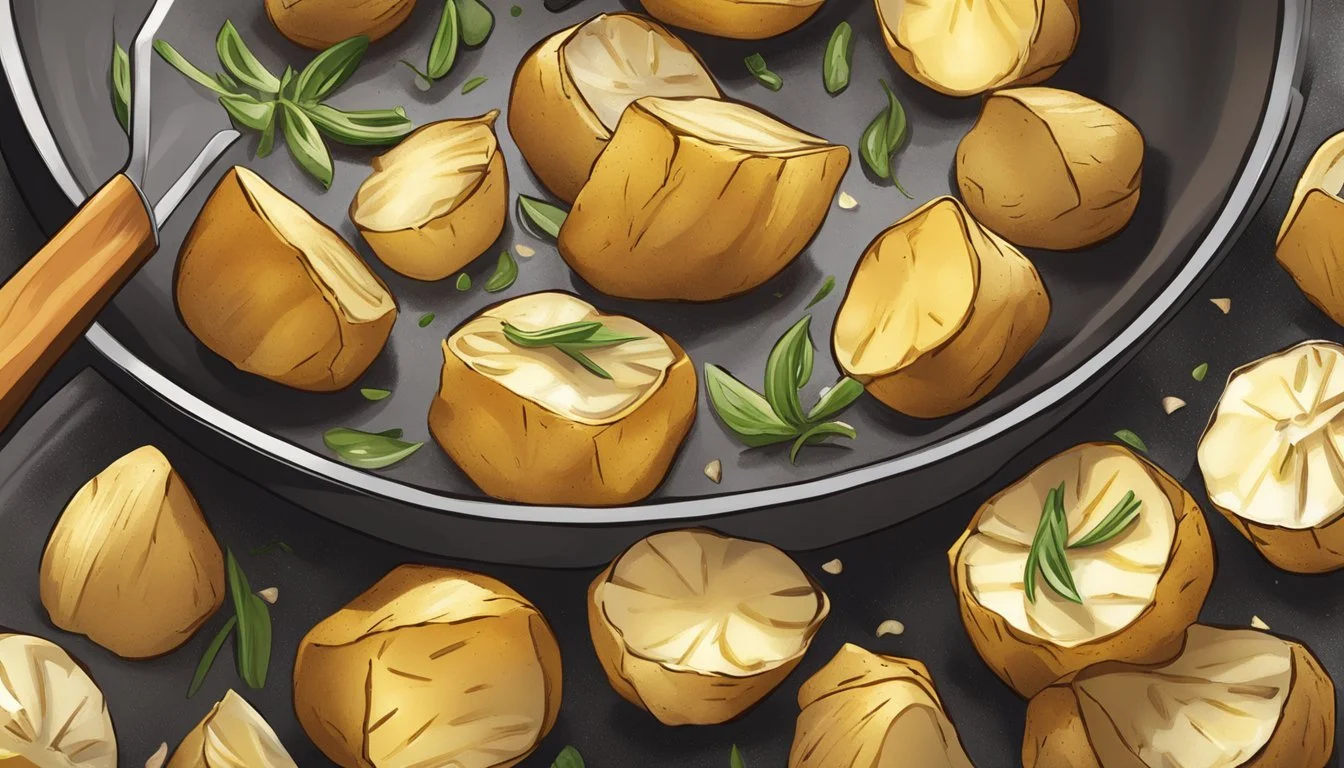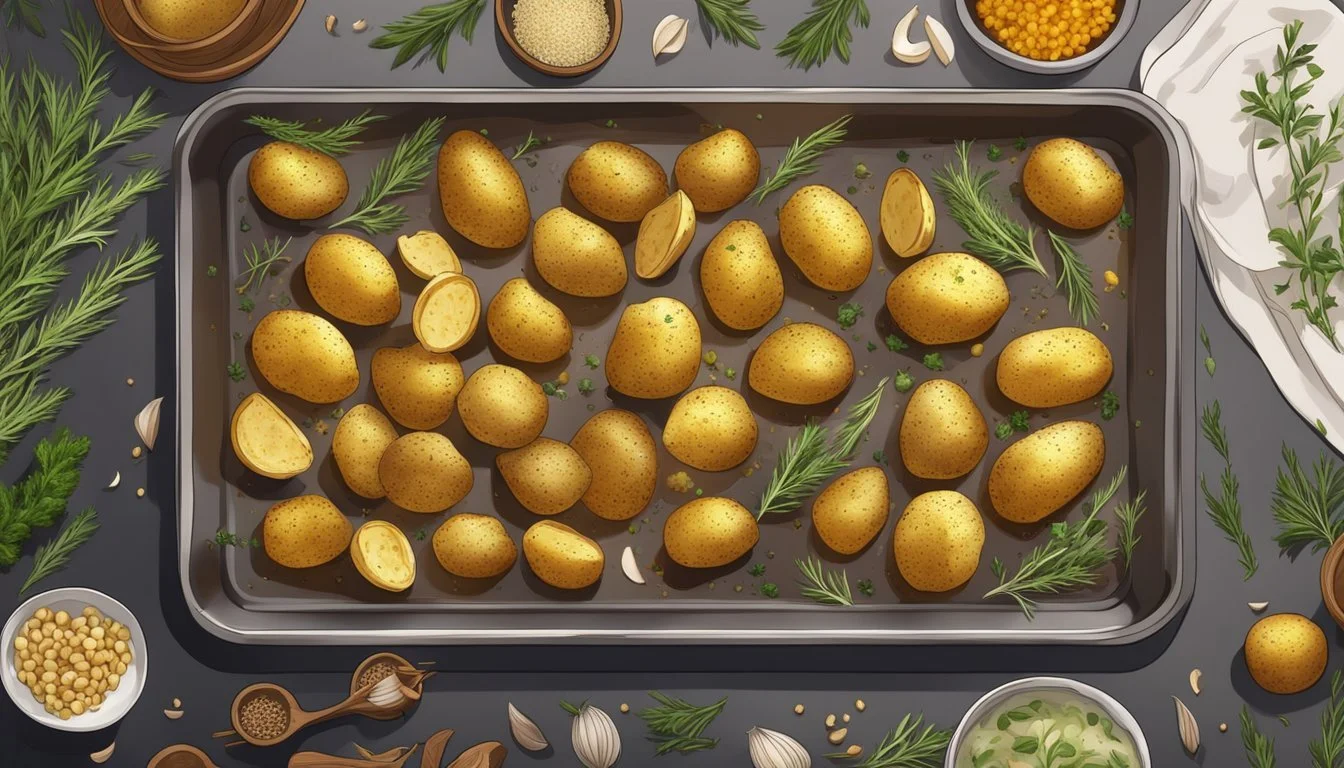Best Way to Reheat Garlic Roasted Potatoes
Tips for Maintaining Crispiness and Flavor
Garlic (What wine goes well with garlic?) roasted potatoes (What wine goes well with potatoes?) are a beloved side dish, known for their crispy exteriors and tender, flavorful interiors. However, one of the most common challenges people face is reheating these potatoes in a way that maintains their distinctive texture and taste. Knowing the best method to reheat garlic roasted potatoes is essential to enjoy them as much as when they were freshly made.
Many turn to the oven as it offers the most consistent results for retaining the crispiness of the potatoes. The key to success lies in the reheating technique, which involves a careful balance of temperature and time. This method not only ensures that the potatoes warm through to the center without becoming soggy, but also rejuvenates the robust flavor of garlic that can mellow during refrigeration.
Understanding Reheating Fundamentals
When reheating garlic roasted potatoes, maintaining the original texture and taste is crucial. The quality of reheated potatoes largely depends on the chosen reheating method. The main objective is to ensure the potatoes are heated through while preserving their crispy exterior and flavorful interior.
Oven Reheating
Temperature: 400°F (200°C)
Duration: Covered with foil for 10-15 minutes, then uncovered for 5 minutes
Key Benefit: Evenly warms and crisps potatoes
Using an oven allows for steady and even heat distribution. Roasted potatoes should be covered with foil initially to warm without moisture loss, then uncovered to regain the crispiness.
Temperature: 350-400°F (175-200°C)
Time: 3-4 minutes
Advantage: Quick and efficient recrisping
An air fryer can be an effective option for smaller portions, providing a rapid reheating process that ensures a crispy finish.
Microwave Reheating should be used as a last resort due to its tendency to make the potatoes soggy. If using a microwave, one should set it to a low power setting and heat in short intervals to avoid overcooking.
Reheating Tips: Always spread potatoes in a single layer on the baking sheet or air fryer basket. Overlapping can result in uneven reheating and loss of crispiness. Additionally, while a toaster oven can be used in a similar fashion to a conventional oven, care must be taken to adjust the temperature and timing due to the smaller size and different heat distribution.
Pre-Reheating Tips
Prior to reheating garlic roasted potatoes, certain preparatory steps ensure the potatoes maintain their texture and flavor. Proper storage practices, preheating methods, and potato preparation are crucial for the best results.
Storage Techniques
Garlic roasted potatoes should be stored in the fridge within two hours of cooking to maintain safety and quality. They are best kept in an airtight container to prevent moisture loss and odor absorption. For longer storage, one can place the cooled potatoes in freezer bags and store them in the freezer. However, it's important to note that the texture may change slightly upon freezing and subsequent reheating.
Preheating Practices
Preheating the oven is a key stage in the reheating process. An oven should be brought to a temperature of 400°F (200°C) before the roasted potatoes are added. This high temperature is essential for restoring the potatoes' crispy exterior. The preheating period also serves as the perfect time to arrange the oven racks to ensure even air circulation around the potatoes during reheating.
Potato Preparation
Before reheating, it's advisable to bring the potatoes to room temperature for about 15 minutes to promote even warming. If the potatoes were previously frozen, one should thaw them in the fridge overnight to ensure they reheat evenly without becoming soggy. Ensuring the potatoes are not overlapping on the baking sheet is critical for achieving an even crispness.
Reheating Techniques for Optimal Crispiness
Proper reheating methods can preserve the crispiness and flavor of garlic roasted potatoes. Each technique varies in its approach to maintain the potatoes' texture while ensuring they are heated through.
Oven Method
One should preheat their oven to 400 degrees Fahrenheit. They need to arrange the potatoes in a single layer, avoiding overlap, on a baking tray with foil or parchment paper. Heating the potatoes, covered with foil, helps prevent drying out and ensures even warming.
Air Fryer Method
To utilize an air fryer, the individual sets the appliance to 350-400 degrees Fahrenheit. They place the potatoes in the basket in a single layer for 3-4 minutes. This method circulates hot air around the potatoes, promoting a crisp exterior.
Skillet Method
A skillet set over medium heat can be effective for reheating. Adding a small amount of oil to coat the bottom, one can spread the potatoes in the skillet. Stirring occasionally, they should reheat the potatoes until they regain their crispiness, being mindful of oil spatters.
Microwave Considerations
While a microwave can soften the texture, one can still use it if necessary. Low heat and short intervals can minimize sogginess. To add some crisp back, they may transfer the potatoes to a hot skillet or oven just after microwaving.
Toaster Oven Strategy
A toaster oven operates similarly to a conventional oven but on a smaller scale. The user preheats their toaster oven to 400 degrees Fahrenheit and reheats the potatoes until they are warm and crisp again, usually taking less time than the oven due to the smaller space.
Post-Reheating Enhancements
Once the garlic roasted potatoes have been sufficiently reheated, achieving that perfect exterior crispness and interior flavor is crucial. The strategies below are focused on ensuring the roasted potatoes are not just reheated, but revived, delivering the same pleasure as when they were first cooked.
Crispness Finishing Touches
To elevate the crispness of the potatoes post-reheating, one can broil the potatoes for 1-2 minutes, watching carefully to prevent burning. This exposes the potatoes to direct heat, creating a desirably crisp exterior. Another tactic is to lightly coat the potatoes with a bit of oil before the short broil. Olive oil or a cooking spray works well and can help avoid a soggy outcome.
Flavor Boosting
The flavor of roast potatoes can be reinvigorated with a sprinkle of fresh seasonings. For garlic roasted potatoes, a fresh addition of finely chopped herbs such as parsley or rosemary after reheating can refresh their aroma and taste. A dusting of grated Parmesan cheese, or a drizzle of a flavored finishing oil like garlic-infused olive oil, can further intensify their savory profile. Remember, the goal is to complement, not overpower, the inherent flavor of the roast potatoes.
Safety and Preservation
When reheating garlic roasted potatoes, ensuring food safety and maintaining the quality for future consumption are crucial concerns. One must consider the proper handling of leftovers to prevent food-borne illnesses and preserve the potatoes' texture and flavor for subsequent storage.
Food Safety Considerations
Reheating garlic roasted potatoes must be done with care to prevent the growth of bad bacteria. Leftover roast potatoes should be cooled to room temperature within two hours of cooking and then promptly placed in the refrigerator. The ideal temperature for storage is below 40°F (4°C), and potatoes should ideally be consumed within three to four days to maintain safety and quality. When reheating, the internal temperature should reach 165°F (74°C), as recommended by food safety guidelines, to ensure that any potential bacteria are destroyed.
Future Storage and Freezing
To preserve the leftovers for a longer period, freezing is a viable option. Garlic roasted potatoes can be frozen for up to three months. Before freezing, one should let the potatoes cool completely and store them in an airtight container or freezer-safe bag to prevent freezer burn. When ready to consume, defrosting in the refrigerator overnight is the safest method. However, to maintain crispiness, it's advisable to reheat them directly from frozen, using an oven or air fryer. One should avoid freezing and defrosting multiple times, as this can turn the potatoes mushy and degrade their quality.
Creative Uses for Reheated Potatoes
Reheated garlic roasted potatoes offer a unique opportunity to repurpose leftovers into exciting new dishes, maintaining their crispy texture and flavor. They can easily transition from a supporting side dish to the star of the meal.
Transforming Leftovers into Main Courses
Leftover roasted potatoes can be transformed into hearty main courses with just a few additional ingredients. They serve as a substantial base, providing both a satisfying chew and filling element.
Potato Hash: Mix them with sautéed onions, bell peppers, and diced ham. Top with a poached or fried egg for a complete meal.
Potato Tacos: Stuff them into tortillas along with cheese, salsa, and shredded lettuce. The crispiness of the reheated potatoes adds a delightful texture to each bite.
The appearance and mouthfeel of these potatoes ensure that even as leftovers, they contribute significantly to the final presentation of any main course.
Innovative Side Dishes
A creative approach can revive reheated roasted potatoes into innovative side dishes that complement a variety of meals. Appliances like ovens and air fryers are ideal for recrisping potatoes before integrating them into these side dishes.
Cheesy Potato Bake: Cube and mix with a blend of cheddar and mozzarella, then bake until bubbly.
Potato Salad: Cool the potatoes and mix with a light Dijon mustard dressing, fresh herbs, and crunchy vegetables for a refreshing side dish.
Each option respects the integrity of the potatoes, keeping the exterior crispy while ensuring they are warm and inviting on the inside.
Conclusion
When it comes to reheating garlic roasted potatoes, the best way is to utilize an oven or air fryer. Southern Living and Taste of Home agree that these methods preserve the crispiness and flavor of the spuds. One should preheat the oven to 400°F and cover the potatoes with foil for about 15 minutes, then uncover them and bake for a few more minutes until they reach the desired level of crispness.
For those short on time or effort, an air fryer can reheat potatoes quickly to achieve a crispy result. Setting the air fryer to 350-400°F and cooking the potatoes for 3-4 minutes should suffice. Although microwaving is faster, it is not recommended if one wants to keep the potatoes crispy.
Here are quick tips for reheating potatoes:
Oven: 400°F for 15 minutes covered, then uncovered
Air Fryer: 350-400°F for 3-4 minutes
Microwave: Not advised for crispiness
Effort plays a role in the results, with the oven and air fryer methods requiring more attention than the microwave, but the taste payoff is worth it. In short, for crispy roast potatoes, put in the extra effort and avoid the microwave.




